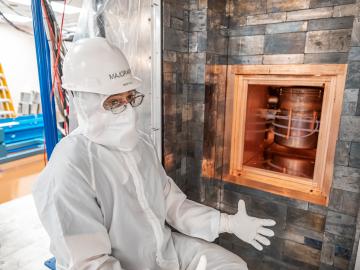
Filter News
Area of Research
- (-) Energy Science (39)
- (-) Materials (99)
- (-) National Security (23)
- Advanced Manufacturing (4)
- Biology and Environment (16)
- Computational Biology (1)
- Computer Science (1)
- Fusion and Fission (4)
- Isotope Development and Production (1)
- Isotopes (27)
- Materials for Computing (15)
- Neutron Science (121)
- Nuclear Science and Technology (15)
- Quantum information Science (4)
- Supercomputing (39)
News Type
News Topics
- (-) Cybersecurity (26)
- (-) Isotopes (13)
- (-) Microscopy (27)
- (-) Neutron Science (42)
- (-) Physics (26)
- (-) Polymers (20)
- (-) Space Exploration (5)
- 3-D Printing/Advanced Manufacturing (89)
- Advanced Reactors (10)
- Artificial Intelligence (24)
- Big Data (11)
- Bioenergy (32)
- Biology (15)
- Biomedical (11)
- Biotechnology (5)
- Buildings (35)
- Chemical Sciences (33)
- Clean Water (10)
- Composites (19)
- Computer Science (50)
- Coronavirus (15)
- Critical Materials (18)
- Energy Storage (81)
- Environment (67)
- Exascale Computing (3)
- Fossil Energy (2)
- Frontier (3)
- Fusion (7)
- Grid (43)
- High-Performance Computing (13)
- Hydropower (3)
- Irradiation (1)
- ITER (1)
- Machine Learning (20)
- Materials (94)
- Materials Science (84)
- Mathematics (3)
- Mercury (3)
- Microelectronics (1)
- Molten Salt (3)
- Nanotechnology (39)
- National Security (36)
- Nuclear Energy (25)
- Partnerships (20)
- Quantum Computing (3)
- Quantum Science (13)
- Security (15)
- Simulation (4)
- Statistics (1)
- Summit (8)
- Transportation (68)
Media Contacts

For nearly six years, the Majorana Demonstrator quietly listened to the universe. Nearly a mile underground at the Sanford Underground Research Facility, or SURF, in Lead, South Dakota, the experiment collected data that could answer one of the most perplexing questions in physics: Why is the universe filled with something instead of nothing?

A scientific instrument at ORNL could help create a noninvasive cancer treatment derived from a common tropical plant.

Warming a crystal of the mineral fresnoite, ORNL scientists discovered that excitations called phasons carried heat three times farther and faster than phonons, the excitations that usually carry heat through a material.

U2opia Technology, a consortium of technology and administrative executives with extensive experience in both industry and defense, has exclusively licensed two technologies from ORNL that offer a new method for advanced cybersecurity monitoring in real time.

Three scientists from the Department of Energy’s Oak Ridge National Laboratory have been elected fellows of the American Association for the Advancement of Science, or AAAS.

Scientists at the Department of Energy’s Oak Ridge National Laboratory are leading a new project to ensure that the fastest supercomputers can keep up with big data from high energy physics research.

The U.S. Departments of Energy and Defense teamed up to create a series of weld filler materials that could dramatically improve high-strength steel repair in vehicles, bridges and pipelines.

Oak Ridge National Laboratory researchers serendipitously discovered when they automated the beam of an electron microscope to precisely drill holes in the atomically thin lattice of graphene, the drilled holes closed up.

While studying how bio-inspired materials might inform the design of next-generation computers, scientists at ORNL achieved a first-of-its-kind result that could have big implications for both edge computing and human health.

Although blockchain is best known for securing digital currency payments, researchers at the Department of Energy’s Oak Ridge National Laboratory are using it to track a different kind of exchange: It’s the first time blockchain has ever been used to validate communication among devices on the electric grid.


